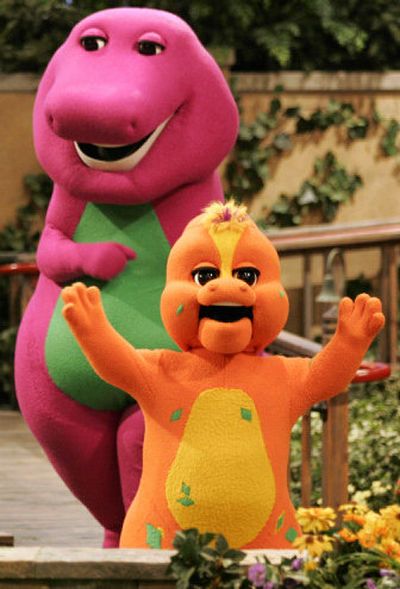Barney says, ‘I’m back’

He’s big, he’s purple and he’s not going anywhere.
Barney, the sugary sweet dinosaur loved by toddlers, is back for another season on public television, where he has been singing and dancing for 14 years.
There’s a new twist to the old story, as well: The first new dinosaur to appear in 13 years on the Texas-based show will join the main character alongside the usual cast of adoring children.
The familiar strains of “I love you, you love me” will echo for many years to come if executive producer Karen Barnes has her way. Barnes sees a limitless future for the sappy reptile.
“It’s an iconic character, part of the culture,” she said. “We have a new audience every two or three years. What Barney teaches doesn’t go out of style.”
The new season that kicks off today adds a new splash of color, a tiny orange hadrosaur named Riff. The pint-sized cousin of Barney’s pals BJ and Baby Bop loves music, showing his enjoyment when his crest blinks with colorful light.
Riff is also featured in a new direct-to-DVD release and will join the cast this fall in “Barney Live! The Let’s Go Tour!”
“You don’t want to continue doing the same things over and over. You want to keep it fresh,” said Barnes, in her second year with the program. “I think a show that’s been on this long, it’s important that we add new elements.”
Former teacher Sheryl Leach, who noted her 2-year-old son’s fascination with dinosaurs at a museum exhibit, created the first Barney program, sold at video stores beginning in 1987. The show has aired on PBS since 1992.
HIT Entertainment acquired the company that produces “Barney,” Allen-based Lyrick Studios, in 2001 for $275 million.
The program is produced in the Dallas suburb of Carrollton, inside an unadorned red brick building that bears no hint of the beehive of activity within.
Inside, carpenters hammer away on set designs, elaborate props are constructed, voices and sounds are recorded and dance routines are rehearsed. The child actors who perform with Barney even have their own classroom and teacher.
Barney really is two people, as are each of his dinosaur sidekicks.
The athletic Carey Stinson is the hopping, dancing person inside the 30-pound purple suit. The distinctive voice, locked away in a dark sound room above the parklike set, belongs to former Radio Disney Deejay Dean Wendt.
Wendt and Stinson work so closely together that they can engage in impromptu conversation with a visitor – as Barney – without missing a beat.
“I’m a firm believer that if you can imagine it, it will happen, so this fits for me, this job,” Wendt said.
Barney’s popularity has declined from a decade ago, but the show still consistently ranks among the top 20 among all children’s programs, including PBS broadcast and cable outlets.
“We know what our target audience loves,” Barnes said. “We know that moms love us.”
There is no dispute that Barney evokes strong reactions from children and adults.
The huggable T-rex has found himself the object of increasing derision over the years by some who find his act a bit too sweet. Many anti-Barney sites have been launched on the Internet.
Others question what young children are getting out of the program.
“It’s sweet, but it lies. It tells them that he loves them. I don’t want my children thinking love is what you get from a guy on TV,” said Angela Harms, a Eugene, Ore., mother of four who maintains an anti-Barney Web page.
Harms says on her Web page that “the kids on Barney & Friends would follow him off a cliff, if he sang a snappy song.”
Barnes, who once worked for the Jim Henson Co., said criticism comes with the territory when you’ve been around as long as Barney has.